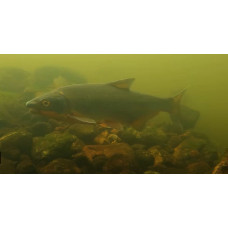Vimba vimba is a fish belonging to the carp family. They inhabit the waters of Western Europe and the European part of Russia. The mouth is lower, semilunar, on the back behind the dorsal fin there is a keel covered with scales. The only species of the genus. Reaches a length of 40 cm, weight 0.8 kg, usually 25-30 cm, weight 200-400 g. Passable, semipassable, partly freshwater fish.
The Black Sea-Azov passerine Vimba vimba (Vimba vimba carinata) enters rivers with immature eggs in the fall and overwinters. Spawning is portioned, in spring. Eggs are bottom. sticky. Fecundity 27-115 thousand eggs. The semi-passable Caspian Vimba vimba (Vimba vimba persa) enters rivers in spring. It spawns in May-June, fecundity 25-28 thousand eggs. All forms feed on benthos, larvae of aquatic insects, mollusks, bokoplavy. Valuable commercial fish.
It grows to about 25 to 45 centimeters (9.8 to 17.7 inches) with a weight of up to 2 kilograms (4.4 pounds). The scales are small and there are about sixty of them along the lateral line. This fish has a deep bluish-green color on the dorsal surface and silvery on the sides. The eyes are yellow and the pectoral and pelvic fins have reddish-yellow bases. Coloration becomes brighter during the breeding season, and in males operculum, the base of the fins and belly can become orange, on the head and body appears "pearl rash". Fecundity up to 115 thousand eggs. Spawning is portioned. It feeds on benthic invertebrates.
Widespread in fresh waters and brackish estuaries of rivers flowing into the Caspian, Black and Baltic Seas, as well as in the North Sea basin in the Elbe and Ems basins. There are records from Armenia, Austria, Azerbaijan, Belarus, Bulgaria, Czech Republic, Estonia, Finland, France, Georgia, Germany, Hungary, Iran, Latvia, Lithuania, Moldova, Netherlands, Poland, Romania, Russia, Serbia and Montenegro, Slovakia, Sweden, Switzerland, Turkey and Ukraine.
A semi-perennial fish that migrates from brackish water to rivers to spawn. There are also permanent freshwater populations. In the Baltic Sea, the species is distributed up to 62°-63° north latitude in Sweden and Finland.
They move in small schools along the sea coast, feeding on invertebrates they collect from the seabed and the eggs of other fish. They leave the sea in May or June, swimming upriver to spawn in fast-moving tributaries with rocky or gravelly substrates and little vegetation. The males prepare several sections of the riverbed on which the females lay batches of eggs.
Vimba vimba
Tags: vimba vimba



